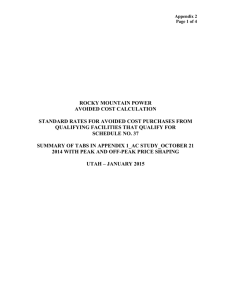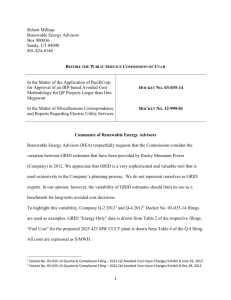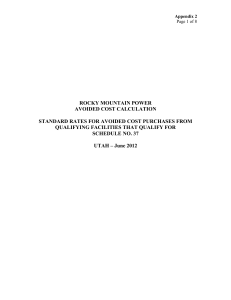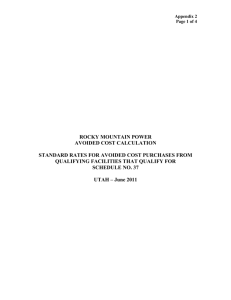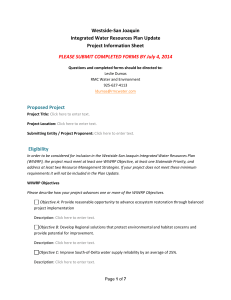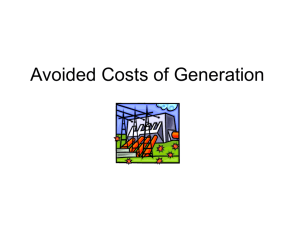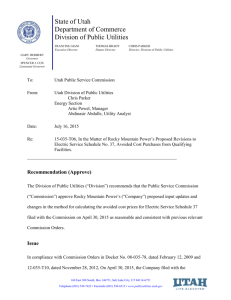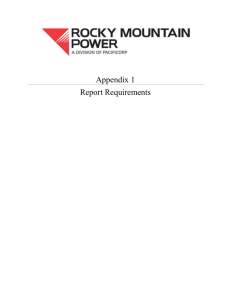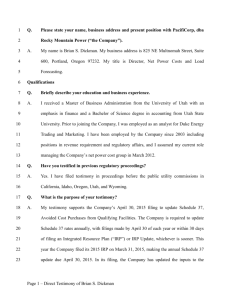Exhibit B - Utah Public Service Commission
advertisement
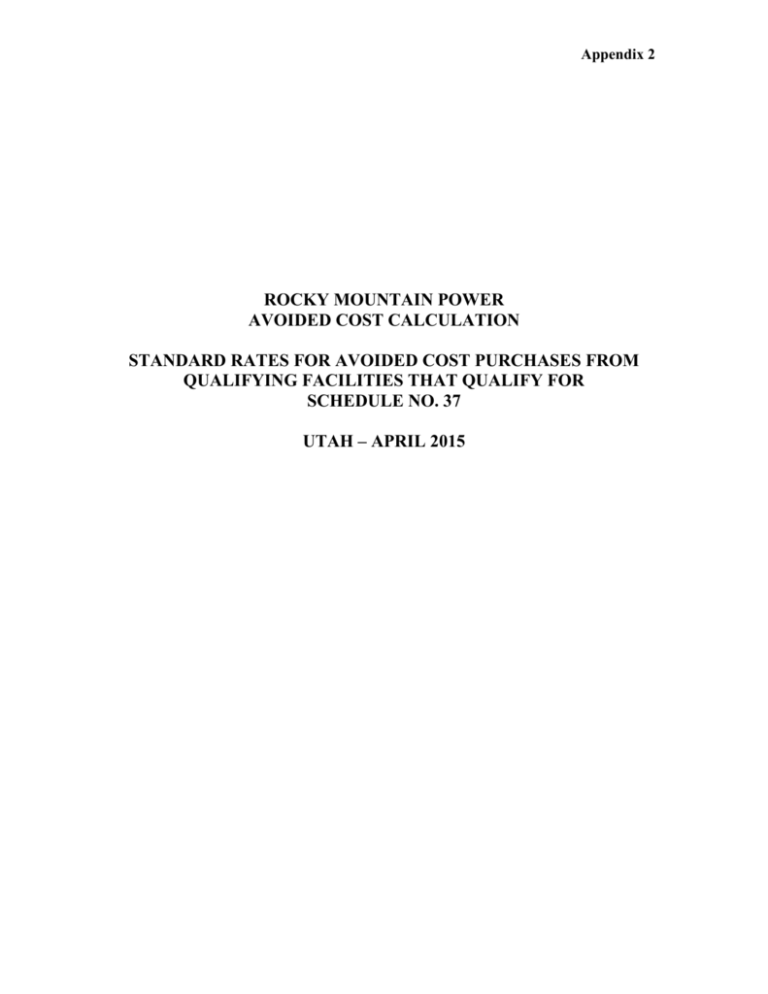
Appendix 2 ROCKY MOUNTAIN POWER AVOIDED COST CALCULATION STANDARD RATES FOR AVOIDED COST PURCHASES FROM QUALIFYING FACILITIES THAT QUALIFY FOR SCHEDULE NO. 37 UTAH – APRIL 2015 Appendix 2 Page 1 of 6 ROCKY MOUNTAIN POWER AVOIDED COST CALCULATION STANDARD RATES FOR AVOIDED COST PURCHASES FROM QUALIFYING FACILITIES THAT QUALIFY FOR SCHEDULE NO. 37 UTAH – APRIL 2015 Overview In compliance with the Commission’s February 12, 2009, Order in Docket No. 08-035-78 on Net Metering Service, PacifiCorp (the “Company”) calculates and files Schedule No. 37 avoided costs annually in order to establish the value or credit for net excess generation of large commercial customers under the Schedule No. 135 Net Metering Service.1 To perform this calculation, the Company uses the Commission approved Schedule No. 37 avoided cost methodology prescribed in Docket No. 94-2035-03, as modified by Docket Nos. 03-035-T10 and 12-035-T10. The methodology used in this filing is consistent with the Commission’s January 16, 2015 and February 13, 2015 dated orders in Docket Nos. 14-035-T04 and 14-035-55, with the following exceptions: On-peak avoided cost rates during sufficiency period do not include the fixed costs of a simple cycle combustion turbine (“SCCT”). Avoided energy costs are differentiated into on-peak and off-peak rates based on the relationship of Palo Verde on-peak and off-peak market prices to Palo Verde flat market prices, respectively. During resource sufficiency period, the Company’s avoided energy costs are based on the displacement of purchased power, existing thermal resources and Front Office Transactions (“FOTs”) from 2015 IRP as modeled in the Company’s GRID model. 1 Docket No. 08-035-78, February 12, 2009 Order, U.P.S.C 24 (2009). Appendix 2 Page 2 of 6 Resource Sufficiency / Deficiency Period In its November 28, 2012, order in Docket No. 12-035-T10 the Commission clarified the methodology to be used to determine the resource sufficiency and deficiency period. The Commission Ordered: We will rely on the Company’s [Integrated Resource Plan (IRP)] process and the Company’s planned actions as articulated in its IRP or IRP update action plans as the basis for identifying the type and timing of a deferrable resource and therefore the time period in which the proxy plant method will be used to calculate energy and capacity payments for Schedule 37 during the period of resource deficiency. Table 1 presents the timing of deferrable resources as listed in Table 5.5 of the Company’s 2015 IRP filing dated March 31, 2015. Table 1 shows that the Company intends to acquire several combined cycle combustion turbines (“CCCTs”) including a 423 MW CCCT in 2028. The 423 MW CCCT scheduled for 2028 is the Company’s next deferrable resource in the 2015 IRP filing and 2028 marks the start of the avoided cost resource deficiency period. In its Order in Docket No. 09-035-T14, the Commission directed the Company “to label Table 1 with the applicable planning reserve margin assumption (e.g., 12 or 15 percent) in all subsequent filings of Schedule No. 37 rates.” The IRP uses planning reserves to account for operating reserves, regulating reserves, load forecast errors and other planning uncertainties. As shown on Table 1, the 2015 IRP utilized a 13 percent planning reserve margin. Avoided Cost Calculation Based on the timing of the next deferrable resource shown in Table 1, the avoided cost calculation is separated into two distinct periods: (1) the Short Run – a period of resource sufficiency (2014 through 2027); and (2) the Long Run – a period of resource deficiency (2028 and beyond). Consistent with the Commission’s January 16, 2015 and February 13, 2015 orders in Docket Nos. 14-035-T04 and 14-035-55, avoided costs are adjusted for wind and solar qualifying facilities (“QFs”) to reflect the approved capacity contribution. Capacity Appendix 2 Page 3 of 6 contribution values of 20.5%, 68%, and 84% are used for wind, fixed solar and tracking solar, respectively. The Company filed its most recent capacity contribution study in October 2014 in Docket No. 14-035-55. Once the Commission issues its decision regarding the proposed capacity contribution values, the proposed Schedule tariff 37 rates will need to be revised. Avoided costs are also adjusted for wind and solar QFs to reflect integration costs. Solar resources are distinguished as configured either to maximize energy output (“Fixed Solar”) or to maximize output during peak load periods or with a tracking device (“Tracking Solar”). Table 10 provides the details of the approved level of integration costs for wind and solar resources. 1. Short Run Avoided Costs During periods of resource sufficiency, the Company’s avoided energy costs are based on the displacement of purchased power, existing thermal resources and FOTs from the 2015 IRP as modeled by the Company’s GRID model. To calculate short-run avoided costs, two GRID production cost studies are prepared. The only difference between the two studies is an assumed 10 aMW resource in northern Utah, at zero running cost. The 10 aMW resource serves as a proxy for QF generation. The avoided energy cost could be viewed as the highest variable cost incurred to serve total system load from existing and non-deferrable resources. Avoided energy costs are differentiated into on-peak and off-peak rates based on the relationship of Palo Verde on-peak and off-peak market prices to Palo Verde flat market prices, respectively. The outputs of the GRID production cost model run and the differentiated on-peak and off-peak avoided energy costs are provided in Table 2A. Tables 2B, 2C, and 2D for wind, solar-fixed and solar-tracking QF types, respectively, which include the impact of integration costs during the short run period. The results of the GRID runs are provided in Confidential Appendix 3 (“UT Sch 37 - Appendix 3a GRID AC Study CONF _2015 04.xlsm” 17_Proposed and “UT Sch 37 - Appendix 3b GRID AC Study CONF _2015 04 17_Proposed.xlsm”. Appendix 2 Page 4 of 6 Capacity costs of a SCCT have been removed from the sufficiency period consistent with the Commission’s order in Docket No. 12-035-100 and consistent with the Company’s 2015 IRP. Prior to the start of the deficiency period in 2028, the Company will not procure additional thermal capacity resources; rather, it will utilize front office transactions, or short-term wholesale market purchases, to meet its needs. In the Commission’s Order dated October 31, 2011, in Docket 11-035-T06 the Commission directed the Company to show how hedging gains and losses relate to the Schedule 37 rates. Hedging gains and losses are included as a fixed cost in the GRID studies used to calculate short-run avoided energy costs in the same manner as they are included in general rate case proceedings. In the calculation of short-run avoided costs, natural gas hedging gains and losses allocated to gas-fired resources fluctuate to the extent plant dispatch is altered by the addition of the 10 aMW zero cost resource. 2. Long Run Avoided Costs During the resource deficiency period (2028 and beyond), avoided costs are the fixed and variable costs of a proxy resource that could be avoided or deferred. The current proxy resource is a CCCT.2 Since CCCTs are assumed to be built as base load units that provide both capacity and energy under the Utah Schedule 37 methodology, the fixed costs of this unit are split into capacity and energy components. The fixed cost of a SCCT, which is assumed to be acquired as a capacity resource under the Utah Schedule 37 methodology, defines the portion of the fixed cost of the blended resource that is assigned to capacity. Consistent with the Commission Order in Docket No. 03-035-14, 50% of the fixed costs associated with the construction of the CCCT resource in excess of the fixed costs of a SCCT are assigned to energy and are added to the variable production (fuel) costs of the CCCT 2 423 MW CCCT Dry "J", Adv 1x1 - East Side Resource (5,050') at Dave Johnston Brownfield site as listed in the 2015 IRP Table 6.2 . Fuel costs are from the Company’s March 2015 Official Forward Price Curve. Appendix 2 Page 5 of 6 resource to determine the total avoided energy costs. Table 3 shows the capitalized energy costs. The fuel cost of the CCCT defines the avoided variable energy costs. The gas price forecast used as the basis for the CCCT fuel cost is discussed later in this document. Table 4 shows the CCCT fuel cost, the addition of capitalized energy costs at an assumed 71.3%3 capacity factor and the total avoided energy costs. Avoided energy costs can be differentiated between on-peak and off-peak periods. To make this calculation, the Company assumed that all capacity costs are incurred to meet on-peak load requirements. On an annual basis, approximately 56% of all hours are onpeak and 44% are off-peak. Table 5 shows the calculation of on-peak and off-peak avoided energy prices. For informational purposes, Table 6 shows a comparison between the avoided costs currently in effect in Utah and the proposed avoided costs in this filing for a base load QF. The 20 year nominal levelized prices are calculated using a 6.66% discount rate4 as listed on page 141 of the 2015 IRP. Table 7 shows the calculation of the total fixed costs and fuel costs of the CCCT and SCCT that are used in Table 3 and Table 4. In this filing, the Company’s next deferrable resource is a CCCT located on the east side of the Company’s system. This result is consistent with the Company’s addition of an east side CCCT in 2028 as modeled in the 2015 IRP. Costs and the payment factors are listed in Tables 6.1 and 6.2 of the 2015 IRP. 3 The 71.3% capacity factor is the combined energy weighted capacity factor of the CCCT Dry "J", Adv 1x1 resource (78%) and the CCCT Dry "J", Adv 1x1 duct firing (12%) included in the 2015 IRP. See Table 6.2 in the 2015 IRP. 4 The discount rate equates to PacifiCorp’s after-tax weighted cost of capital. Appendix 2 Page 6 of 6 Price Forecast for Electricity and Natural Gas The natural gas price used in this filing is from the Company’s Official Forward Price Curve (“OFPC”) dated March 31, 2015. Forward prices for electricity are based on the March 31, 2015, OFPC. Both the electricity and natural gas prices are inputs to the Company’s GRID model in the calculation of the proposed avoided costs. Table 8 shows the natural gas price used to calculate the fuel costs of the CCCT that is the proxy resource for the Long Run avoided costs, and Table 9 shows the electricity prices at Mid-Columbia and Palo Verde that are used in the Company’s avoided cost calculation on a heavy-load hour and lightload hour basis.
